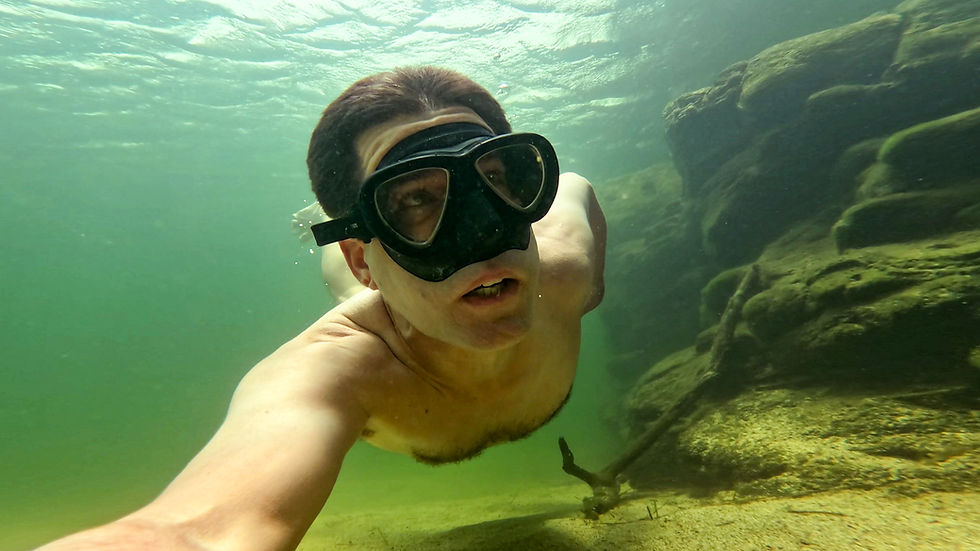The depth limits of diving
- Michael Mutter

- 9. Nov. 2023
- 3 Min. Lesezeit
Aktualisiert: 28. Apr. 2024
In recent years, extreme divers have set new depth records. In February 2023, for example, hydrogen was used with a rebreather for the first time, reaching a depth of 230 m during a cave dive. But where are the absolute depth limits when diving outside a pressurized body?
The golden age of saturation diving is over since the 1980s after the oil crisis subsided. As part of their growing global ambitions, India and China in particular have launched new deep-sea research programs in recent years, which are not limited to developing remotely operated and manned deep submersibles, but are also reviving saturation diving programs. For example, China successfully completed a 500-meter deep dive experiment in a pressurized chamber in 2021 and plans to repeat the dive in open water. In light of this, there has been renewed interest in the question of where the absolute depth limits lie for saturation divers. A publication attempts to answer this question.
The question of the maximum depth for saturation dives has acquired new interest.
Saturation diving was developed to avoid extended decompression periods between dives. In this process, divers remain in pressurized habitats for several days or weeks, from which they make their dives. At constant high pressure, the breathing gases in their body tissues saturate. As depth increases and ambient pressure rises, divers find themselves increasingly exposed to the effects of breathing gases.
To prevent the "rapture of the deep" caused by increased nitrogen partial pressure in the breathing gas, which leads to restlessness, impaired thinking and ultimately unconsciousness, nitrogen is replaced in the breathing gas from a depth of about 40 m by helium, which has a less narcotic effect. However, at the latest from a diving depth of 150-200 m, the use of helium-oxygen mixtures leads to high-pressure neurologic syndrome (HPNS), characterized by tremors, uncontrolled muscle contractions, electrical brain activity changes and concentration disorders. Slow descent rates and the admixture of nitrogen and hydrogen (the latter also to overcome the problem of high breathing gas density) to the breathing gases nevertheless allowed much greater depths to be reached: 534.4 m (54.4 bar) in the open sea and 71.1 bar in hyperbaric chambers, corresponding to a simulated depth of 701 m.
In addition to HPNS, psychotic syndromes are another obstacle to very deep diving. They occur under any breathing gas mixture when diving sufficiently deep and manifest as disorganized thought and behavior, hallucinations, and agitation before turning into narcosis. They thus correspond to the "rapture of the deep" induced at shallower depths by nitrogen.
Psychotic symptoms and narcosis mark the absolute limit of deep diving.
The narcotic effect of respiratory gases is usually explained by their lipid solubility using the Meyer-Overton correlation. This correlation is known to be insufficient, as has already been stated in this blog. Oxygen, for example, should have a much stronger narcotic effect than it does in reality. The authors therefore use the "critical volume" model for their considerations. This states that narcosis (with the described preceding symptoms of psychosis) occurs when the volume of a cell region (e.g. the brain) is "inflated" beyond a certain critical volume by the inhalation of an inert gas (such as nitrogen, helium or hydrogen). Regardless of the type of gas mixture and the depth of immersion, it is found that symptoms always occur at the same critical volume.
From this now known critical volume, a depth of 1000 to 1200 m can be calculated for the most optimal breathing gas, a hydrogen-oxygen mixture, at which any diver becomes psychotic and thus incapable of action, and which thus marks the absolute limit of diving outside a body that protects human beings against overpressure. Animal experiments with primates support this theoretical consideration and show similar symptoms from about 101 bar, corresponding to 1000 m depth.
Dives beyond 1000 to 1200 meters depth are virtually impossible outside a body that protects against overpressure.
These considerations suggest that dives beyond 1000 to 1200 meters depth are practically impossible unless an even more optimal gas than hydrogen were used in the breathing gas mixture, which is only conceivable in science fiction.
It is important to note that these considerations do not take into account the problem of increasing density of the breathing gas due to increasing diving depth. This represents another difficult obstacle to overcome for very deep dives.





Kommentare